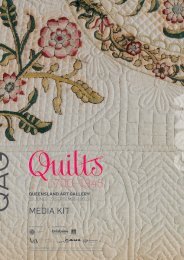Queensland Art Gallery - Queensland Government
Queensland Art Gallery - Queensland Government
Queensland Art Gallery - Queensland Government
Create successful ePaper yourself
Turn your PDF publications into a flip-book with our unique Google optimized e-Paper software.
Kyungah Ham<br />
Communication beyond the unreachable place<br />
The work of Kyungah Ham reflects on the way images structure our<br />
understandings of cultural politics, militarised conflict and social activism.<br />
Employing imagery from past and present-day exemplars found on the<br />
internet — and using traditional artisanal techniques for their reproduction<br />
— Ham’s work foregrounds the way these images are circulated and<br />
interpreted within popular culture and online communication. Inspired<br />
by the use of the propaganda poster bill for disseminating dissident<br />
views, Ham’s work explores the significance of past atrocities for<br />
contemporary audiences and asks: how can an individual’s actions<br />
have agency within the context of international politics?<br />
In her 2008 solo exhibition ‘Such Game’, 1 Ham presented her first<br />
series of textile works produced in North Korea (DPRK). Collecting<br />
images sourced through the online search engine Google, Ham<br />
covertly sent composite imagery and photomontages to female<br />
artisans in the DPRK (via China) to be hand-embroidered using<br />
traditional techniques and materials. The project began as a means of<br />
opening up communication with North Koreans about local anxieties<br />
and foreign politics that influence everyday lives on both sides of the<br />
Korean border. In undertaking this charged exchange, Ham sought<br />
to enact a dialogue across the barriers of ideology and physical<br />
distance. Owing to the political sensitivities of the works, many of<br />
the embroideries have been confiscated by DPRK officials; in some<br />
instances, the textiles are sent back to Ham by the artisans in pieces,<br />
to be reconfigured on their receipt in South Korea.<br />
In the diptych Nagasaki Mushroom Cloud, Hiroshima Mushroom Cloud<br />
2008, Ham reproduces two of the most recognisable images of modern<br />
warfare: the 1945 atomic bombings of Hiroshima and Nagasaki by the<br />
United States. These aerial views depict the nuclear mushroom clouds<br />
in stark black and white, devoid of flaming colour; concealed beneath<br />
is the destruction, devastation and unseen effects of radiation. As<br />
images of the world’s only wartime nuclear attacks, the photographs<br />
continue to conjure anxieties over nuclear proliferation in a post-Cold<br />
War era. For Korean audiences, their reception is further complicated<br />
by the shaping of these events in mainstream Korean history. While<br />
large numbers of Koreans interned in Hiroshima and Nagasaki labour<br />
camps were casualties of the bombings, acknowledgment of their<br />
experiences is shadowed by Korea’s liberation and independence<br />
from the prewar Japanese empire.<br />
mimics military strategy and imagery. On the surface, the burning<br />
skyline of New York on September 11 2001 is relocated to the<br />
jungles of Vietnam. Below, a labyrinth, connected by staircases and<br />
passageways, reveals fragmented images and signifiers — piles of<br />
skulls are a stark reminder of massacres carried out in Cambodia by<br />
the Khmer Rouge regime; the back of an anonymous man recalls the<br />
‘Tank Man’ of the 1989 Tiananmen Square protests in Beijing; and, in<br />
a more abstract illustration, Wandjina figures painted by Aboriginal<br />
people from the Kimberley region of Western Australia evoke the<br />
trauma of colonisation. 3 These diverse images were selected by the<br />
artist as enduring symbols of conflict and resistance that the North<br />
Korean artisans would need to consider while transforming the source<br />
images into embroideries.<br />
Ham’s embroideries offer a strange and compelling mixture of<br />
propaganda, personal memory and social agency. Given the labourintensive<br />
process of hand embroidery, Ham’s project might be<br />
interpreted as utilising the participatory process of labour as a form of<br />
political enactment and transformation. For Kyungah Ham, the contrast<br />
between her ability to spontaneously access information online and<br />
the limited access her collaborative artisans have prompts a desire<br />
to ultimately, as she puts it, attempt ‘communication beyond the<br />
unreachable place’. 4<br />
Jose Da Silva<br />
Endnotes<br />
1 ‘Such Game’ was held at SSamzie Space in Seoul in 2008. In addition to the textile<br />
works, the exhibition included a series of white porcelain sculptures of Kalashnikov<br />
rifles and related weaponry, which were decorated with traditional landscape<br />
paintings and the pattern of a Persian carpet traced with the oil residue of Iraqi<br />
military supplies.<br />
2 Kyungah Ham, email to the author, 10 August 2009.<br />
3 Wandjina is the Aboriginal name for ancestral spirits who control the seasons and<br />
rain patterns. The painting of Wandjina figures forms part of important ceremonial<br />
practices at sacred sites for the people of the West Kimberley region. The<br />
appropriation of these figures, by those not permitted to paint or reproduce<br />
these images, is the subject of continued debate.<br />
4 Ham, email to the author.<br />
In Some Diorama 2008, Ham interweaves representations of war,<br />
colonialism and trauma — what she terms images ‘representing hidden<br />
terrorism, a hidden political brutality’ 2 — into a network resembling a<br />
platform video game. Based on a miniature diorama of the Vietnam–<br />
US War (1959–75) — illustrating key events within a complex of secret<br />
caves and tunnels used by the North Vietnamese — Some Diorama<br />
explores the way these particular images register with a media-literate<br />
public, as well as their influence on video game culture, which often<br />
Kyungah Ham<br />
South Korea b.1966<br />
Nagasaki Mushroom Cloud, Hiroshima Mushroom Cloud<br />
2008<br />
Hand embroidery on silk / Diptych: (a) 120 x 150cm;<br />
(b) 120 x 150cm / Sigg Collection, Switzerland / Image<br />
courtesy: The artist and Kukje <strong>Gallery</strong>, Seoul<br />
90 91
















